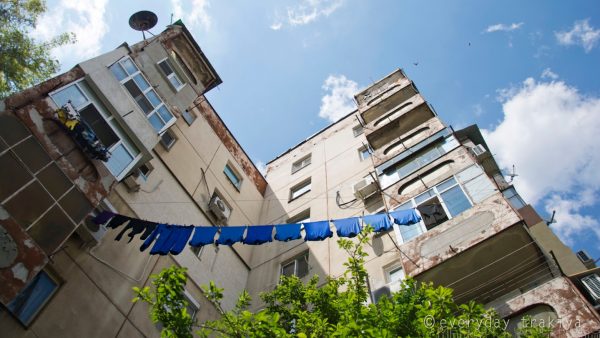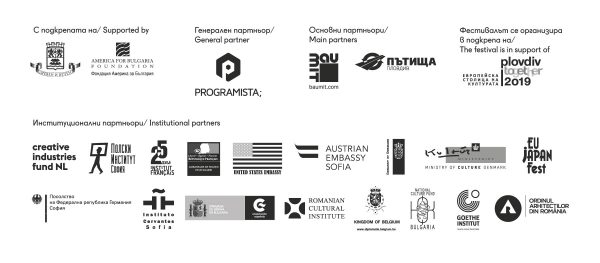
The ninth issue of the festival discusses the transforming power of citizen participation in forming the urban environment
The 9th edition of ONE ARCHITECTURE WEEK enters the socialist collective housing neighbourhood will focus on the mechanisms of citizen participation. For the main location and the subject of the festival the organizers chose Trakiya, a typical Bulgarian socialist panelki dormitory-neighbourhood from the 70’s. With the motto ACTION! Towards a neighbourhood practice and a significant program OAW aims to go beyond a festival’s pattern, and is already acting on the ground developing tools in an attempt to start a practice of the neighbourhood.
The official Opening will be on 30th September, the so called “Day of Trakya”. The festival’s program is rich on different activities between 30.09 and the 8-9.10 weekend, when the Forum will gather 16 speakers from 14 countries.
The festival will explore and learn from the everyday experiences of living together accumulated by a socialist collective housing neighbourhood. The central topic which is being interpreted by a research, exhibitions, interventions and a forum, is the transforming power of the of citizen participation in forming the urban environment. The curator of ONE ARCHITECTURE WEEK 2016 is the Romanian architecture studio studioBASAR.
The main events during the festival will be situated in an ex-halle and in the empty space between the first three panelki of Trakya.
“Trakiya, the location and the subject of the festival, is a typical Bulgarian socialist panelki dormitory-neighbourhood from the 70’s. Build upon an optimistic vision of a prefabricated future, Trakiya’s planned mechanistic solutions were radically altered by economic, social and political actions. It was the inhabitants of Trakiya that took action and further developed its laboratory vocation. With intuition as its fuel, the neighbourhood assimilated change through transformation and adaptation”, says the manifesto.
ACTION! Towards a neighbourhood practice will act in two ways. On one hand it will engage the laboratory that was Trakiya during the last 50 evenly divided years between socialist and capitalist systems. And, on the other hand, it will set in motion participative processes and construct support structures for the collective production of the neighbourhood.
“The panelki are often a subject of emotional discussions – whether they are ugly, comfortable, a symbol of Communism, a nightmare etc. The fact is that they are a home for a significant number of Bulgarian citizens and have become a subject of the city folklore. But what is most valuable is that in these housing estates you could study the citizens participation in the process and its effect, says Lubo Georgiev, the festival’s director.
Forum – 8-9 October
The FORUM this year will last for two days, October 8th and 9th and will see the participation of 16 speakers from 3 different continents. Those lectures are the only paid part of ONE ARCHITECTURE WEEK.
For the 2016 edition of the FORUM of ONE ARCHITECTURE WEEK we have invited people from different parts of the world, who have experience in involving citizens in the design, creation and maintenance of the urban environment. Some of them are architects, others are academics, and we even have activists on board. Some will focus on the panelki type of neighbourhoods, others will talk about other examples of urban tissue. What they all have in common is that they not only believe, but have also proven that citizen participation is a valuable resource, which can contribute greatly for an urban environment of high quality.
One of the most prominent participants in the program are Jan Gehl from Dennmark and Momoyo Kaijima from Japan.
Moderator of the Forum will be Hristo Stankushev, co-curator of ONE ARCHITECTURE WEEK 2014 and pattern at dontDIY.
Main intervention
Every year ONE ARCHITECTURE WEEK realises a number of interventions in public space with two main goals: experiment and sustainability. To experiment: with a physical structure, which addresses issues of the the festival’s main topic and location. Sustainability: to leave a positive trace of change in the area, which it has engaged with.
Thе main intervention of 2016 happens at an open-air public green space, located between blocks 1, 2 and 3 in Trakiya. It is an underused space, which the festival wants to help turning into a common good. It features all the characteristics so typical for a Bulgarian panelki neighbourhood: uncared areas of grass and vegetation, abandoned kids playground, lack of parking places, etc. But it also features, again typically for such a Bulgarian urban area, small gardens taken care by certain inhabitants, besedkas, benches and tables placed by the citizens themselves, repairs of the pavement and other public infrastructure realised by the locals. This specifically chosen green area is both specific, as well as generic. Bulgarian cities are full of such areas.
The aim is to create a number of physical structures, which work as a showcase of how citizen participation can be integrated into the planning process.
The intervention is a collaboration between different architects. A Polish, a French and an Austrian team each work on three different, but yet well-coordinated installations. Prior to their participation a Bulgarian team, INFormal, was involved. INFormal managed the first stage of the intervention: analysis and design brief. In the course of 10 days they set up a mobile structure, which was used for gathering people and organising events. In this process they observed how inhabitants move and use the space, what are the different interest groups, what do people wish or hate about the space, etc. On the basis of their observations and a number of interviews, they put together a design brief for the three foreign teams. Based on this brief, the foreign teams gave initial ideas, which INFormal put for discussion with the locals once again. Afterwards the final designs were drafted. As a last step of the realisation, the local inhabitants are involved once more.
The whole process aims to serve as an example both to the locals, as well as the authorities, of how people can be fruitfully involved in creating, changing and maintaining the urban environment. ONE ARCHITECTURE WEEK strives to encourage a process of urban transformation, characterised by participation, transparency and durability.
Exploring the transformations of the neighbourhood of Trakiya
“LIVING SPACES” is the main exhibition in the festival’s program and it uses the neighbourhood of Trakiya as a case study, presenting the coexisting work of architects and inhabitants as equally valuable. The curator of the exhibition is Megan Lueneburg. It unfolds the processes of design and adaptation, overlapping them to reveal a new perspective of how we understand housing.
Organised from the individual apartment to the urban plan, the progression through the exhibition is the way in which an inhabitant experiences the neighbourhood everyday. Inside to outside – exactly the opposite of how an architect typically approaches the design of such a neighbourhood – from outside to inside. As a living laboratory, the exhibition provides an interactive opportunity to review how we can learn from the creative processes that continue to shape Trakiya.
During ONE ARCHITECTURE WEEK 2016 will be presented a very detailed research of Trakya which results are gathered in a book and a film – a video interview, which brings together some of the architects of Trakiya, a 40 year old panelka neighbourhood that has housed over 80,000 people since its creation. The film is produced by ONE ARCHITECTURE WEEK and is conceived and directed by Lina Krivoshieva and Megan Lueneburg.
An important element of ONE ARCHITECTURE WEEK is the kids program. In the context of the topic “citizen participation” the festival initiated already in March this year, a pilot project called “Urban awareness”. Its main aim is to test the possibility of spatial education in Bulgarian schools. The pilot took place in a school in Trakiya and caused much interest in the education community. The project’s ambition is to introduce such education in multiple schools across Bulgaria.
The festival is organised by the ONE Foundation for Culture and Arts and is supported by the Plovdiv Municipality and the America for Bulgaria Foundation. General partner is Programista, while Patishta Plovdiv are main partners of the event. The festival supports Plovdiv – European Capital of Culture 2019 and is has received an award in 2015/2016 from EFFE – Europe for festivals, festivals for Europe.
Institutional partners are Creative Industries Fund, Polish Institute Sofia, French Institute Sofia, USA Embassy in Sofia, Embassy of Austria in Sofia, The Romanian Cultural Institute, Embassy of Denmark in Sofia, EU JAPAN FEST, Embassy of Germany in Sofia, Embassy of Belgium in Sofia, Instituto Cervantes en Sofia, National Fund Culture, Goethe-Institut.

Photo credit: Megan Lueneburg
